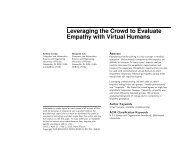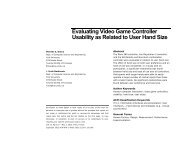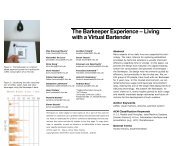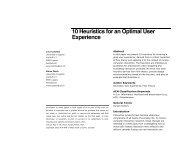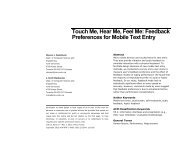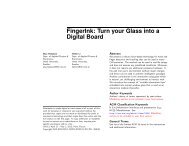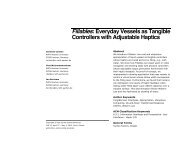Neurodiversity & HCI - alt.chi 2013
Neurodiversity & HCI - alt.chi 2013
Neurodiversity & HCI - alt.chi 2013
You also want an ePaper? Increase the reach of your titles
YUMPU automatically turns print PDFs into web optimized ePapers that Google loves.
Gifted neurodiverse<br />
individuals<br />
Einstein: Dyslexia,Autism.<br />
Paul Dirac: Autism<br />
Mozart: ADHD<br />
Shakespeare: ADHD<br />
Tracey Emin: Dyslexia<br />
Ludwig van<br />
Beethoven:Autism<br />
Michael Faraday: Dyslexia<br />
Dr. Samuel Johnson:<br />
Tourettes<br />
For example, a dyslexic in a pre-literate society would<br />
have little difficulty functioning and find the positive<br />
aspects of the condition useful. It is the switch to near<br />
universal literacy and society’s dependence on high<br />
literacy which then denies a dyslexic access to the<br />
resources that creates dependence on external<br />
assistance which is the mark of disability. There is little<br />
doubt discrimination and disability exist. Examples of<br />
such discrimination for dyslexics are: education<br />
commensurate with IQ is refused [8] , employment<br />
opportunities may be restricted [6], in the US, their<br />
unemployment is twice as high compared to those<br />
without learning disabilities[11] wages may be less<br />
than their able and equally qualified counter<br />
parts[17][18], ability to rise to higher levels of<br />
management curtailed [21], some fear downgrading,<br />
career termination or dismissal if their difference is<br />
revealed [22]. It is for this and other reasons that<br />
Dyslexia is defined as a disability and employment<br />
protection legislation exists under the Americans with<br />
Disabilities Act[19] and the UK disability discrimination<br />
Act.<br />
From these examples it should be clear that disability is<br />
more about the inability to function in a neurotypical<br />
society to a greater extent than being able to function<br />
in some absolute sense. As Finkelstein says “The<br />
central issue in our campaign is for a better life,<br />
therefore, we ought to be concerned with issues around<br />
emancipation and this requires struggles for social<br />
change rather than concentrating on individual<br />
experiences, ‘rehabilitation’, etc” [16].<br />
It is this struggle with emancipation and social change<br />
that the neurodiversty movement seeks to foster. From<br />
an <strong>HCI</strong> perspective, optimizing the interaction with<br />
software with only one cognitive model is slowly<br />
eroding it’s use by those with differing cognitive<br />
strengths and weaknesses. As designers and builders<br />
of tools with a particular cognitive perspective, we are<br />
potentially engaging in the further disenfran<strong>chi</strong>sement<br />
of a number of groups and so creating more disability.<br />
3. Spectrum of Disorder<br />
The final aspect which makes neurodiversity stand out<br />
and makes its highly relevant for <strong>HCI</strong> is the spectrum<br />
observations from D<strong>alt</strong>on’s[13] observations that most<br />
neurodiversity conditions are spectrum disorders<br />
ranging from normal to dysfunctional. One of the<br />
problems with conditions like dyslexia and Asperger’s<br />
syndrome is that it is hard to give a definite diagnosis<br />
about who is or isn’t afflicted with the condition. Figures<br />
on the prevalence of dyslexia for example range from<br />
1-15% of the population due to the operational<br />
definition of how severe the condition is expected to be<br />
in order to be categorized as dyslexia. We must also<br />
consider that the negative and positive sides of a<br />
condition can impact an individual at different rates.<br />
This becomes clear when we consider the work of<br />
Baum[7], looking at the education of gifted and<br />
learning disabled individuals, Baum observes that the<br />
range of those with intellectual differences may be<br />
larger than those simply labeled ‘learning disabled’.<br />
Baum suggests there are three categories of<br />
‘giftedness’:<br />
• Identified gifted students who have subtle<br />
learning disabilities- these are students who<br />
fall only slightly short of the vision of genius.<br />
They have some shortcomings but their gifts<br />
greatly outweigh any negatives, the overall<br />
result is still worthy of the label ‘gifted’.



